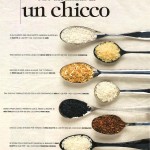I heard about this last week when I was at NBPGR in New Delhi, but it’s quite surprising to see it in the popular press. Just goes to show how important mango is in India. With funding from the Sultanate of Oman, the Indian Council of Agriculture Research (ICAR) is going to produce a catalogue of all the mango varieties of the world. Sounds like a monumental enterprise. But, given the news lately about loss of varieties, very timely. Hope the wild relatives will be included.
Around the world in a grain of rice
A great image of agrobiodiversity from Italian Grazia magazine, with thanks to Linda for cutting it out and saving it for me. It’s not online, so this is a scan. Click on the image to enlarge it. The spoonfuls are, from the top:
1. arboreo rice for risotto
2. long-grain basmati rice
3. mixture of rice, oats and Khorasan wheat
4. Sisa rice for sushi
5. black Venere rice
6. long-grain red rice
7. basmati again
8. mixture of unmilled rices
Variegation is mimicry?
The suggestion has just been published that leaf variegation may have evolved as a defence mechanism against being eaten. Variegated leaves look like they’ve already been attacked, so they’re avoided by pests. Working on an Ecuadorian rainforest floor aroid, researchers found that
While moths infested almost 8% of green leaves, they infested 1.6% of variegated ones and just 0.4% of those painted to look like they were variegated.
Damn, another paper to read. This one is in Evolutionary Biology.
There are lots of variegated taros. Would it help to scatter a few around a field, I wonder? Or even to invest in some correction fluid…
Nibbles: Vegetable seeds, Colorado potato beetle, Castanea, Pigs, Condiments, Porpoise, Biofuels, Mouflon, Blackwood
- European are growing more vegetables. But how much of that is heirlooms?
- Canadian boffins grow wild potatoes for the leaves.
- Chinese wasp going to roast Italy’s chestnuts.
- The genetics of swine geography. Or is it the geography of swine genetics?
- The diversity of sauces.
- Cooking Flipper.
- Genetically engineered brewer’s yeast + cellulose-eating bacterium + biomass = methyl halides.
- Wild sheep runs wild in Cyrpus.
- “It can be planted in farms because it does not compete for resources with corn, coffee or bananas and acts as a nitrogen-fixing agent in the soil. The mpingo is also considered a good luck tree by the Chagga people who live on the slopes of the Mt. Kilimanjaro.”
Database hell squared beckons?
Colleagues at FAO and Bioversity International have a paper out in the Journal of Food Composition and Analysis entitled “Food composition is fundamental to the cross-cutting initiative on biodiversity for food and nutrition.” The cross-cutting initiative in question is that on biodiversity for food and nutrition which the CBD asked FAO to lead, in collaboration with Bioversity. And by the “food composition” of the title the authors mean databases which document the nutritional value of foods not just at the level of species, as currently, but of the different varieties and cultivars within species. These will in a way be a central pillar of the initiative. We’ve talked here before about the extensive variation that can exist among varieties in nutritional composition, for glycaemic index, say. And we’ve repeatedly highlighted the work of Lois Englberger and her Pohnpei colleagues in this field, for example. So it is good to hear that food composition tables and databases will be improved to allow the inclusion of infra-specific data. Populating the databases will be something else, of course. The data will need to come from existing genetic resources databases, which currently do not as a rule contain much in the way of this kind of information and are not necessarily equipped to handle it. So this initiative will involve a marriage between two database communities, that of nutritionists and that of genebanks. A difficult trick to pull off. Necessary, and long overdue, but difficult. Stay tuned.
